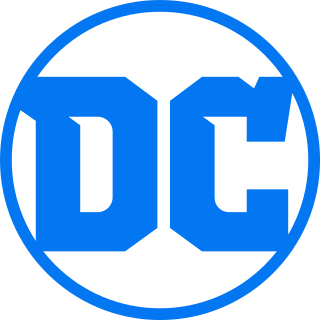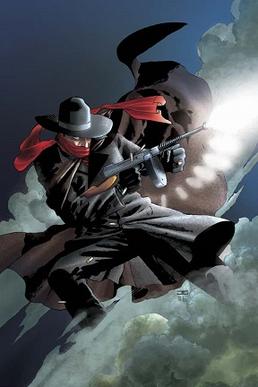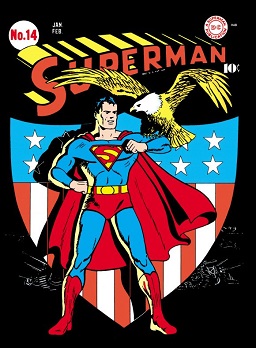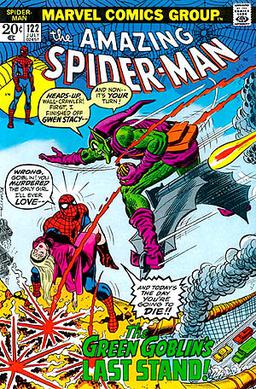Related Research Articles

DC Comics, Inc. is an American comic book publisher and the flagship unit of DC Entertainment, a subsidiary of Warner Bros. Discovery.

Doc Savage is a fictional character of the competent man hero type, who first appeared in American pulp magazines during the 1930s and 1940s. Real name Clark Savage Jr., he is a polymathic scientist, explorer, detective, and warrior who "rights wrongs and punishes evildoers." He was created by publisher Henry W. Ralston and editor John L. Nanovic at Street & Smith Publications, with additional material contributed by the series' main writer, Lester Dent. Doc Savage stories were published under the Kenneth Robeson name. The illustrations were by Walter Baumhofer, Paul Orban, Emery Clarke, Modest Stein, and Robert G. Harris.

The Shadow is a fictional character published in the United States of America by magazine publishers Street & Smith and writer Walter B. Gibson. Originally created to be a mysterious radio show narrator, and developed into a distinct literary character in 1931 by writer Walter B. Gibson, The Shadow has been adapted into other forms of media, including American comic books, comic strips, serials, video games, and at least five feature films. The radio drama included episodes voiced by Orson Welles.

The Golden Age of Comic Books describes an era in the history of American comic books from 1938 to 1956. During this time, modern comic books were first published and rapidly increased in popularity. The superhero archetype was created and many well-known characters were introduced, including Superman, Batman, Robin, Captain Marvel, Captain America, and Wonder Woman.

Mortimer Weisinger was an American magazine and comic book editor best known for editing DC Comics' Superman during the mid-1950s to 1960s, in the Silver Age of comic books. He also co-created such features as Aquaman, Green Arrow, Johnny Quick, and the original Vigilante, served as story editor for the Adventures of Superman television series, and compiled the often-revised paperback 1001 Valuable Things You Can Get Free.

Dark Circle Comics is an imprint of Archie Comics Publications, Inc. Under its previous name, Red Circle Comics, it published non-humor characters, particularly superheroes in the 1970s and 1980s.

The Bronze Age of Comic Books is an informal name for a period in the history of American superhero comic books, usually said to run from 1970 to 1985. It follows the Silver Age of Comic Books and is followed by the Modern Age of Comic Books.

More Fun Comics, originally titled New Fun: The Big Comic Magazine a.k.a. New Fun Comics, was a 1935–1947 American comic book anthology that introduced several major superhero characters and was the first American comic book series to feature solely original material rather than reprints of newspaper comic strips. It was also the first publication of the company that would become DC Comics.
James Noel Mooney was an American comics artist best known for his long tenure at DC Comics and as the signature artist of Supergirl, as well as a Marvel Comics inker and Spider-Man artist, both during what comics historians and fans call the Silver Age of Comic Books and what is known as the Bronze Age of Comic Books. He sometimes inked under the pseudonym Jay Noel.
Romeo Tanghal is a Filipino comics artist who has worked primarily as an inker. He became well known in the industry in the 1980s for his work on DC Comics' The New Teen Titans.
Martin Goodman was an American publisher of pulp magazines, digest sized magazines, paperback books, men's adventure magazines, and comic books, launching the comics magazine company Timely Comics in 1939 that would eventually become Marvel Comics.
Titan Magazines is the magazine-publishing division of Titan Publishing Group. Titan Magazines' publishing directors are Ricky Claydon and John Dziewiatkowski.
The "DC Explosion" and "DC Implosion" were two events in 1978 – the first an official marketing campaign, the second a sardonic reference to it – in which DC Comics expanded their roster of publications, then abruptly cut it back. The DC Explosion was part of an ongoing initiative at DC to regain market share by increasing the number of titles they published, while also increasing page counts and cover prices. The so-called "DC Implosion" was the result of the publisher experiencing losses that year due to a confluence of factors, and cancelling a large number of ongoing and planned series in response. The cancellations included long-running series such as Our Fighting Forces, Showcase, and House of Secrets; new series introduced as part of the expansion such as Firestorm and Steel: The Indestructible Man; and announced series such as The Vixen which would have been the company's first title starring an African-American woman. Former flagship series Detective Comics was also considered for cancellation. Some of the material already produced for these cancelled series was used in other publications. Several of the completed stories were "published" in small quantities as two issues of Cancelled Comics Cavalcade, whose title was a reference to DC's Golden-Age Comic Cavalcade series.

Australian comics have been published since 1908 and Australian comics creators have gone to produce influential work in the global comics industry,

Frederick Whitney Ellsworth was an American comic book editor and sometime writer and artist for DC Comics during the period known to historians and fans as the Golden Age of Comic Books. He was also DC's "movie studio contact", becoming both a producer and story editor on the TV series The Adventures of Superman.
Phil Belbin (1925–1993) was an Australian artist, illustrator, cartoonist and amateur cinematographer. He is probably best known for creating what soon became known as the "Candy" multi-colour livery for the State Rail Authority in the 1980s. He is still regarded as one of Australia's leading steam enthusiasts, and had an extensive personal collection of several small steam locos; loco name plates; builder's plates and other railway memorabilia. His legacy lives on through his extensive film collection which he took in the final two decades of NSWGR steam.
Jack Schiff was an American comic book writer and editor best known for his work editing various Batman comic book series for DC Comics from 1942 to 1964. He was the co-creator of Starman, Tommy Tomorrow, and the Wyoming Kid.

Thorpe & Porter was a British publisher, importer, and distributor of magazines and comic books. At first, the company was known for repackaging American comics and pulp magazines for the UK market. Later on, it became a publisher of original material. The company released more than 160 comics titles in the UK, the most prominent being Classics Illustrated, MAD UK, Edgar Rice Burroughs' Tarzan of the Apes, Larry Harmon's Laurel & Hardy, House of Hammer, and Forbidden Worlds. T & P's most prominent imprints were Top Sellers Ltd. and Brown Watson. Thorpe & Porter operated from 1946 to c. 1979.
References
- Hetherington, John. "This is the House that Paperbacks Built." Age 13 April 1963, p. 22.
- Johnson-Woods, Toni. "The Mysterious Case of Carter Brown: Or, Who Really Killed the Australian Author?" Australian Literary Studies, 21.4 (2004): 74-88.
- --- Pulp: A Collector's Book of Australian Pulp Fiction Covers. Canberra: National Library of Australia (2004).